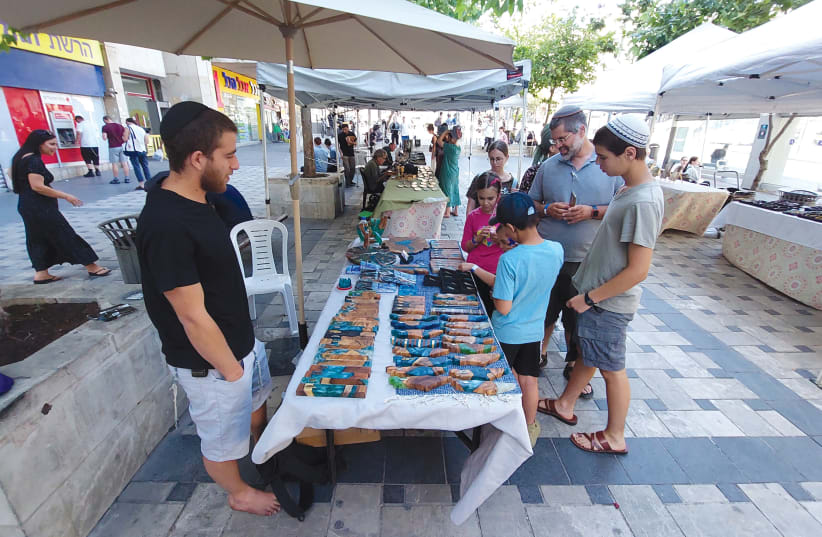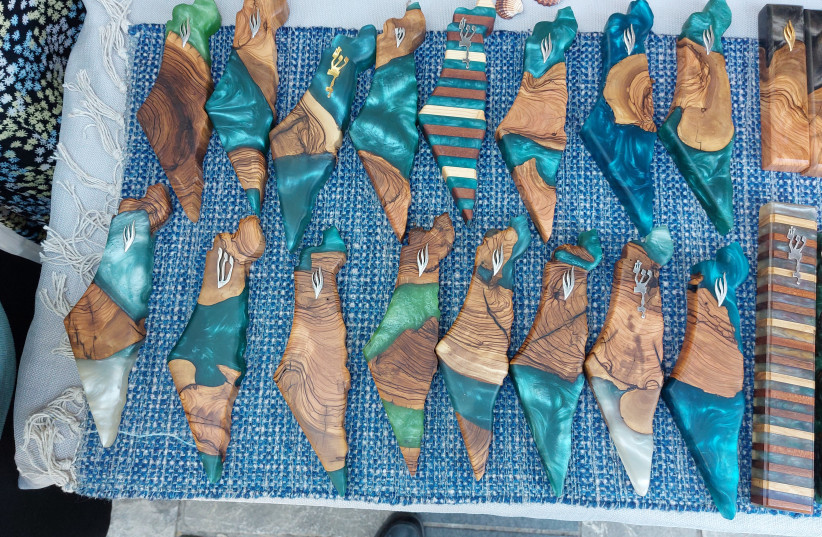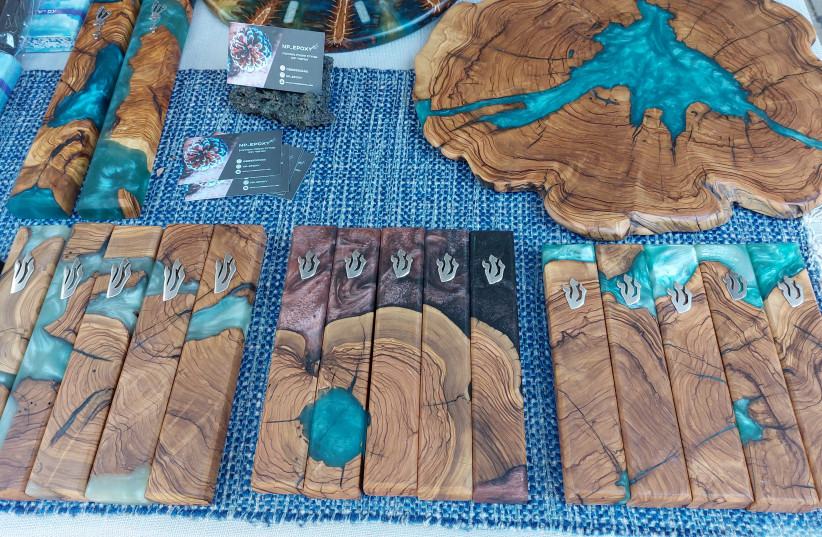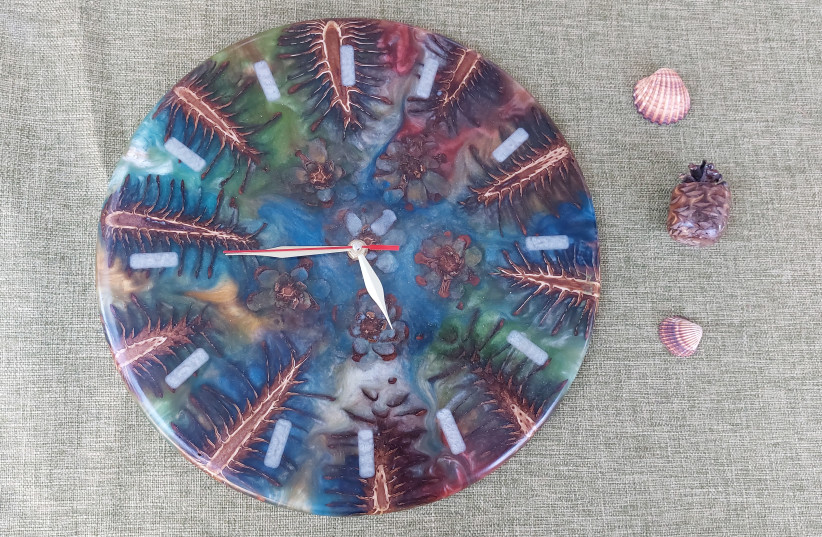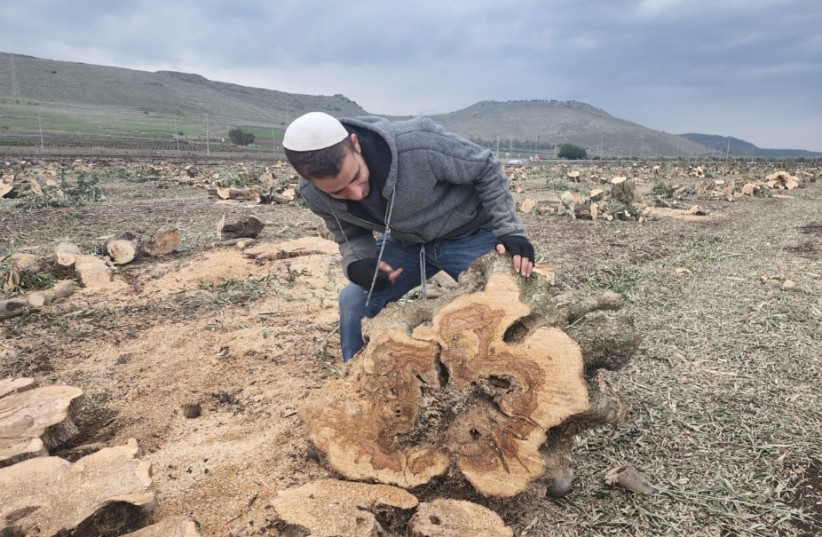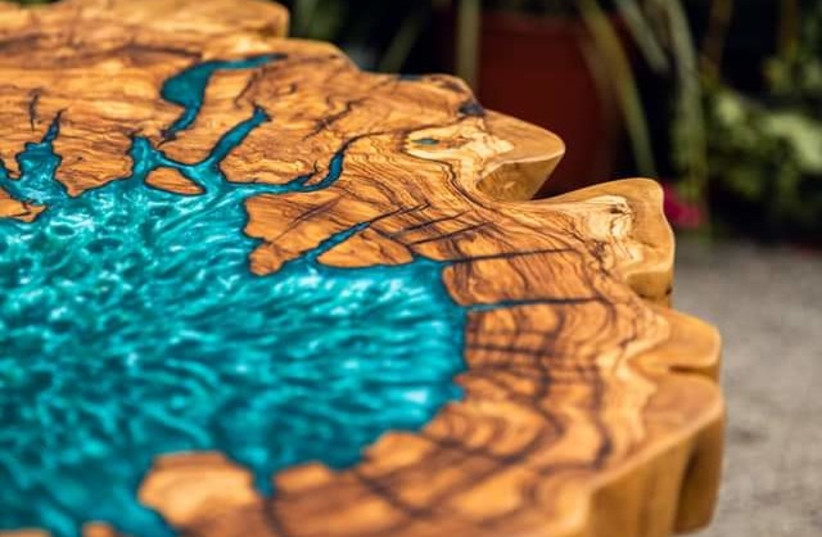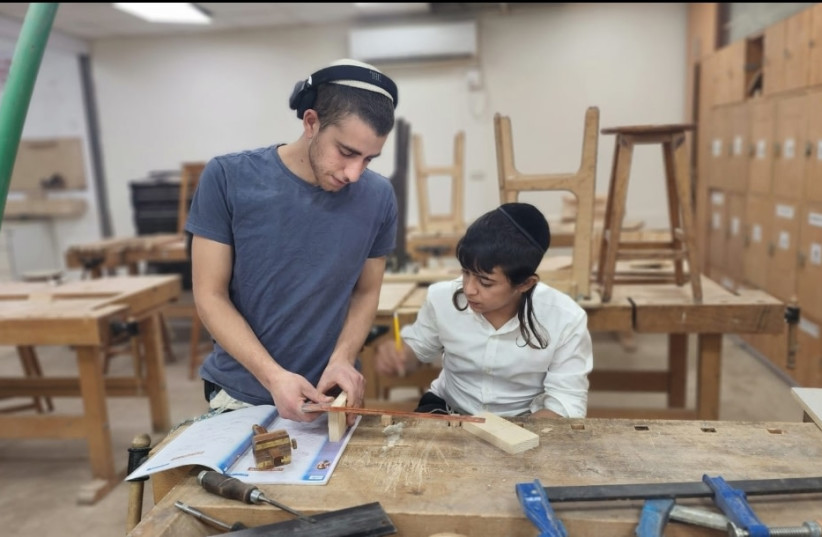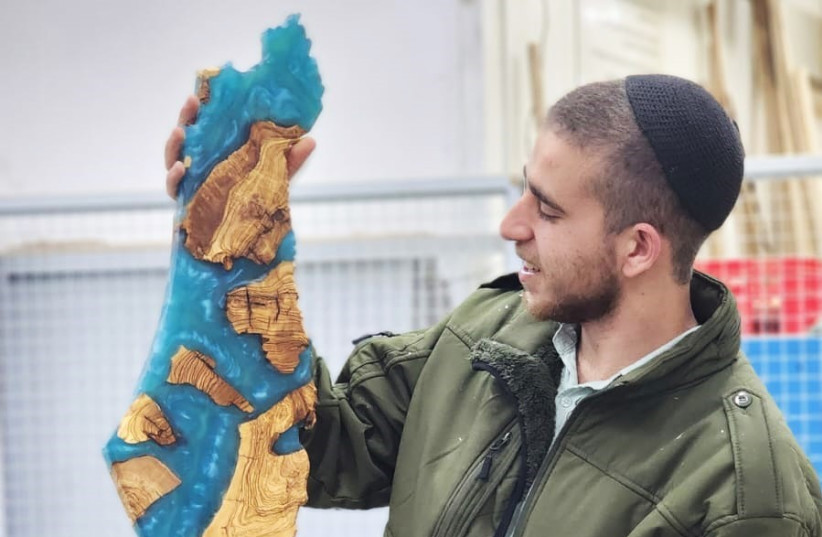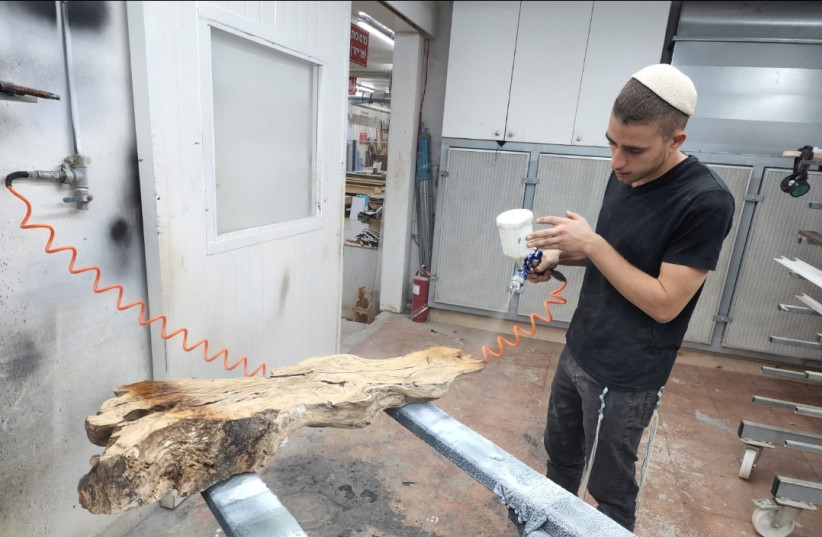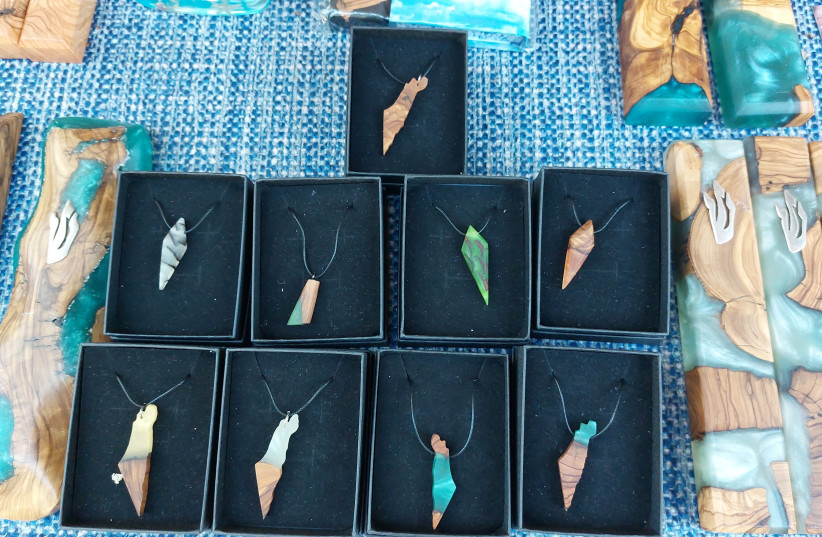
One Friday afternoon a few weeks ago, I found myself among a potpourri of arts, crafts, jewelry, trinkets and treasures – arranged on linen-covered tables and shaded by white portable tents – spread out over the tiled plaza on Jaffa Street, across from Davidka Square, in downtown Jerusalem.
I thought I would just browse a bit until the next train came to take me home to prepare for Shabbat, but one man’s stand caused me to stop and take a closer look.
Neatly arranged on a tablecloth were stunning wood and resin mezuzah creations. Looking at each smooth, seamless composition of waves of olive wood flowing into more waves of turquoise, green, and white resin, I felt like I was gazing down into a clear, deep ocean. Each wood portion was a weaving shoreline for the deep blue sea adjacent to it.
Each piece was like its own land-and-sea world, condensed into a 20- or 25-centimeter mezuzah. Many were standardly shaped, about 20 x 2.5 cm. and 1.5 cm. thick, but what caught my eye were the ones shaped like the Land of Israel. Although they depicted the Land, I felt like I was actually looking into the Mediterranean Sea and the Sea of Galilee (the Kinneret). There were also some Land of Israel necklaces.
For sale were also a few standard-sized sets of five mezuzot, each set clearly fashioned from a single original wood-resin block, making each mezuzah simultaneously an individual piece of art and part of the larger group (as perhaps we should all be).
An amazing resin clock made from embedded pine cone slices and flowers had white resin rectangles representing the hours. And a fascinating hanukkiah echoed the olive wood-and-resin meld design of the mezuzot.
Who is behind all these exquisite resin-and-wood creations?
Standing behind the table, patiently answering curious browsers’ queries, was a smiling, barefoot young man in a black V-neck T-shirt, pale-blue cargo shorts, and blue-and-white tzitzit (ritual fringes). Nadav Pollack, their 19-year-old creator, quietly and happily explained it all to this enthralled and now transfixed passerby.
“I saw some videos on YouTube of people making these kinds of wood and resin pieces. I got very excited and decided to learn how to make them, too,” he told In Jerusalem.
“I started this as a hobby and made a table for my mother at home,” he said. “I realized that I really liked doing this, so I made things for family and friends, and then started a business two years ago. I’ve made three tables since, in addition to many mezuzot and other items.” That first table took him 60 hours to create.
POLLACK HAILS from Beitar Illit and currently lives in Jerusalem. “I work and teach in the boarding school where I myself studied, in Kfar Zeitim (Olive Village) up north near Tzuk Arbel above Tiberias, a place that combines Torah study with professional studies,” he said. An appropriately named place for someone who works with olive wood.
He learned carpentry there for five years, using a CNC (computer numerical control) machine to make kitchens and other large projects. CNC is a time-saving process in which computer software dictates the movement of factory machinery and tools to produce parts and projects, reducing waste and eliminating the risk of human error.
Pollack is a boarding school counselor there for youth from ultra-Orthodox families, young boys who find it difficult to study Torah all day, so they combine professional studies with sacred studies. “I am with the students in the morning and again at night, and during the day I am busy with my carpentry work.”
How does he get the resin to come out so enchantingly beautiful? “It’s an epoxy resin, so it’s a combination of two substances: an epoxy and a hardener,” the artist said. “It’s clear and colorless; I usually combine blue, yellow, and white to make it turquoise. It takes a few hours to harden, and at a certain point I can mix it to get these kinds of patterns,” he said, pointing to some of them.
“Sometimes, I mix the resin with a stick, and sometimes it moves around by itself,” Pollack said. “I don’t make each item individually: I make a large board of olive wood combined with resin, and then cut out the shapes.”
PEOPLE STOPPED at his table, fascinated by his handiwork. Some asked the price: NIS 150 for a basic mezuzah, NIS 350 for a Land of Israel one. He admitted that his prices were low but says that since he makes them at the school with their tools and machines and has no overhead, he doesn’t feel right about charging more – although he recently raised the prices to NIS 180 and NIS 480, respectively. “A simple mezuzah takes me about an hour to make; an Israel one takes up to three hours,” he said.
“I have also made two very big Land of Israel pieces, about 60 by 25 cm.,” he said proudly. “One is hanging in my family’s house; the other I sold to a pilot.” I asked him how much he charged, assuming that it also wouldn’t be enough; NIS 1,500 ($400), he said. I laughed and said that it also wasn’t enough – he agreed. “I made a table 60 by 50 cm. and sold it for NIS 12,000 – it took me 50 hours. I showed it to another artist who said I could have charged the same, but in dollars: $12,000!”
A man approached and asked the craftsman a few questions about a particular mezuzah he was attracted to, thought a little more about it, started walking away, then turned around and came back. The potential buyer did this a few times, but eventually left for good. I asked Pollack why the man didn’t buy it. “There was a little imperfection in the bottom corner that I guess he just couldn’t accept.”
“SO WHAT are you working on now?” I asked.
“Seventy mezuzot, including five sets that have a big one for the front door, and four or five smaller interior ones,” he replied. “I’m also working on a living room table: I’m doing as much as I can until I go to the army in a couple of months.” This caught me a little off guard; I forgot that he was around draftable age.
“Once I’m in, I won’t be making any more until I finish the army – in two years.”
“But I thought it’s three years,” I said.
“I’m joining Netzah Yehuda,” he replied. This is the special IDF Judah’s Victory battalion that attracts ultra-Orthodox men to military service, accommodating their needs and allowing them to fulfill their third year of service in other ways, such as learning a profession – similar to hesder pre-military academies.
“Some of our students join Netzah Yehuda – maybe six or seven a year,” he said.
Two days before my encounter with Pollack, two soldiers from his soon-to-be battalion – Cpt. Israel Yudkin, 22, and Staff Sgt. Eliyahu Haim Emsallem, 21 – were killed in the northern Gaza city of Beit Hanoun.
POLLACK’S OLDER brother Evyatar, like many newly released soldiers, went overseas to see some of the world. He went to Nepal to climb to the Mount Everest Base Camp (EBC): 5,364 meters (17,598 ft.) above sea level. But when he had reached about half way up after three days, he heard about the Oct. 7 Gaza war, so he turned around and came right home to re-enlist.
“He didn’t think it was right to be climbing a mountain while others were fighting to defend his country,” his soon-to-be-serving younger brother said proudly. Evyatar was in Gaza for three months, then went back to Nepal and reached his EBC goal.
“It is my great privilege to serve the people of Israel and the Land of Israel,” the younger Pollack brother said in anticipation of his obligatory military service.
“Do you want to continue doing this as a business when you get out of the army?” I asked.
“Yes. I would like to open my own wood shop, making these kinds of wood-resin items, as well as regular wood products,” he said. “It does me good: I’m connected to all of this work with wood. And I feel good when I help young guys from the yeshiva develop a love – and the skills – for woodworking.”
Pollack wouldn’t be able to afford all the machines and equipment, but “if I find someone who wants to buy up everything I have, OK!” he quietly exclaimed, surprising me that he would part with his entire stock so easily.
In the meantime, what’s left is available on Instagram at NP_EPOXY or by emailing him at nadav1144888@gmail.com. Or go see him across from Davidka Square on Fridays – until he goes off to protect us all. And perhaps don’t be too particular about a little imperfection here and there…■
